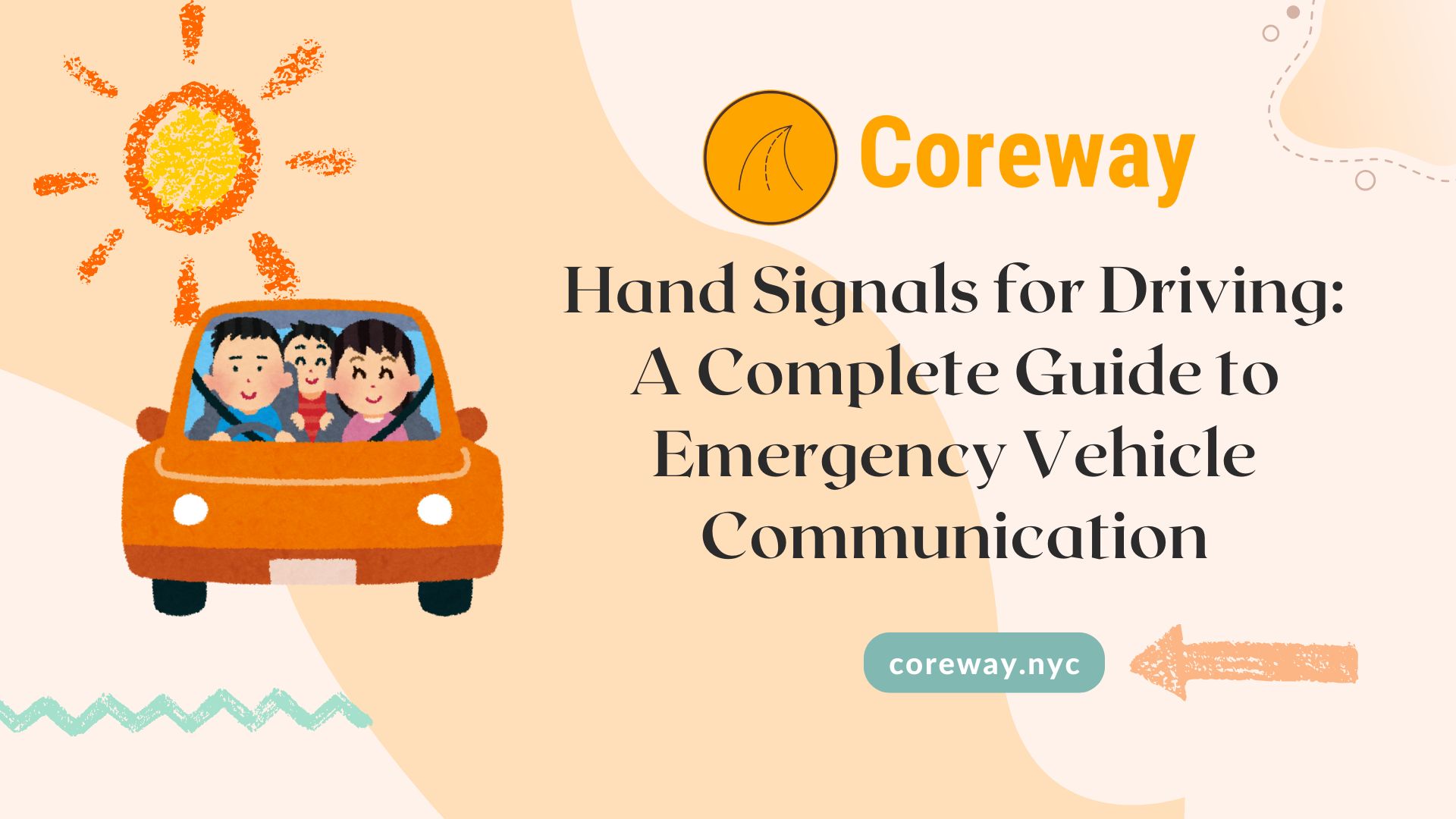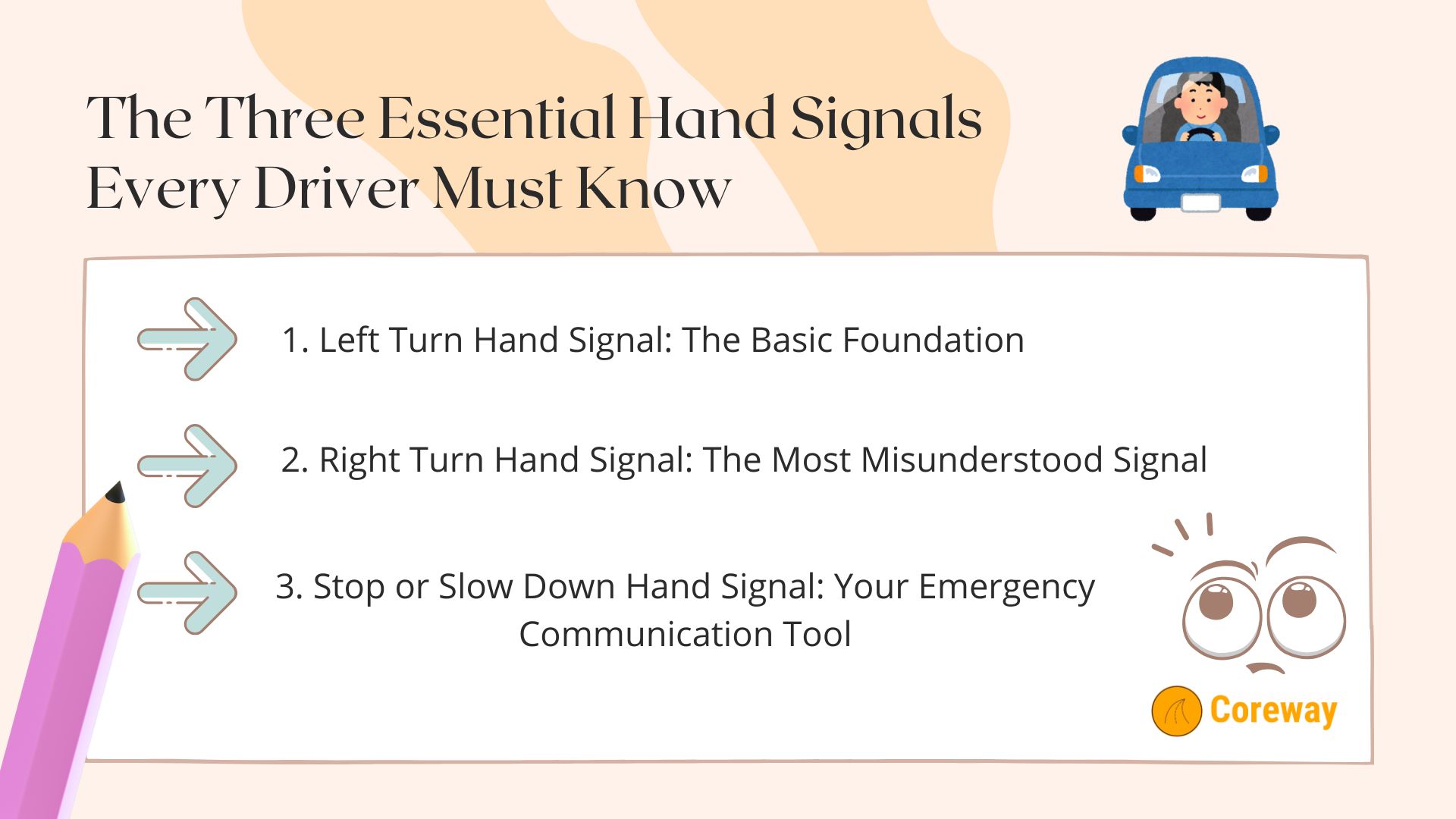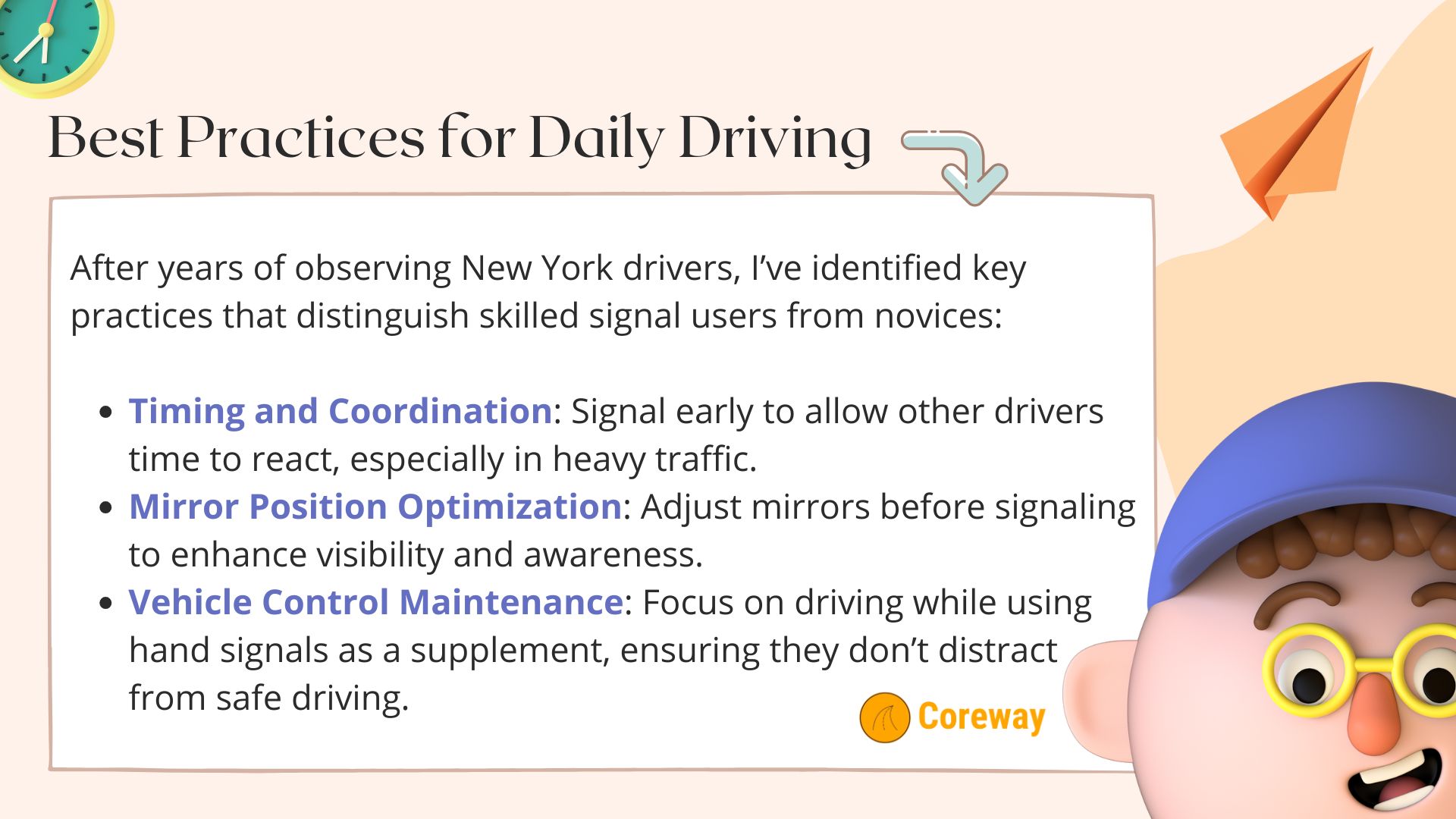Hand Signals for Driving: A Complete Guide to Emergency Vehicle Communication

Table of Contents
- Why Hand Signals Matter in Modern Driving
- Impact on Road Safety and Accident Prevention
- The Foundation: Three Essential Hand Signals
- The Three Essential Hand Signals Every Driver Must Know
- Special Considerations for Different Environments
- Hand Signals in Challenging Conditions
- Legal and Testing Requirements
- Best Practices for Daily Driving
- Safety Tips and Common Mistakes
- Vehicle Maintenance and Signal Safety
- Modern Alternatives and Supplements
- Conclusion: The Future of Hand Signals
Your vehicle's extensive lighting system – from headlights and fog lamps to running lights and turn indicators – serves as your primary communication method with other drivers. However, when these systems fail, hand signals become your crucial backup for safe navigation. Whether you're operating a passenger car, commercial truck, SUV, or even a motorcycle, mastering these universal signals isn't just about meeting legal requirements – it's about ensuring everyone's safety on our increasingly crowded roads.
If you're preparing to get your New York driver's license and want to learn more about hand signals along with other essential driving skills, be sure to check out our 5-Hour Pre-Licensing Course, where you'll get hands-on practice with these crucial safety techniques alongside expert instruction on all aspects of defensive driving.
Why Hand Signals Matter in Modern Driving
The National Highway Traffic Safety Administration (NHTSA) and Department of Transportation (DOT) continue to emphasize hand signals as essential safety measures. Here's why they remain relevant in 2024:
Critical Situations Requiring Hand Signals
- Equipment Failures
- Blown fuses affecting brake lights
- Malfunctioning turn signal switches
- Burned-out tail light bulbs
- Center-mount brake lamp failures
- Environmental Challenges
- Bright sunlight washing out LED signals
- Heavy rain or snow reducing signal visibility
- Dawn/dusk lighting conditions
Legal Requirements and Safety Standards
In New York State, the law requires clear communication of your driving intentions to other road users. While electronic signals serve as the primary method, hand signals are legally recognized alternatives. Here's what you need to know about signaling distances:
|
Location Type |
Required Signaling Distance |
|
Business Districts |
100 feet minimum |
|
Residential Areas |
100 feet minimum |
|
Highways |
200 feet minimum |
|
Lane Changes |
100 feet minimum |
Impact on Road Safety and Accident Prevention
Through my years of teaching defensive driving across New York's diverse road conditions – from bustling Manhattan streets to winding Adirondack highways – I've witnessed countless situations where proper hand signals prevented potential accidents. When electronic systems fail, these universal gestures provide an invaluable backup communication system.
Real-World Applications
Consider this common scenario: You're driving home during rush hour when your brake lights suddenly fail. Without working brake lights, vehicles behind you have no warning when you slow down or stop. This is where the standardized stop signal becomes critical – extending your arm downward with palm facing backward clearly communicates your intentions to following drivers.
Similarly, imagine approaching a crucial turn at a busy intersection just as your turn signal malfunctions. In this situation, a clear hand signal can mean the difference between a safe turn and a dangerous misunderstanding with other drivers.
The Foundation: Three Essential Hand Signals
Before we delve into specific techniques, it's important to understand that these signals are standardized across all 50 states. This uniformity ensures that whether you're driving a compact car in Brooklyn or a commercial truck on the interstate, other road users will understand your intentions.
The three fundamental signals correspond to the most crucial driving maneuvers:
- Left turns and lane changes
- Right turns and lane changes
- Stopping or slowing down
Each signal has been carefully designed to be:
- Distinctly visible to other drivers
- Comfortable for the signaling driver to execute
- Clear in meaning across different lighting conditions
- Safe to perform while maintaining vehicle control
Call Us Today 6AM-10PM
Or fill out the form 24/7
Our team is here to guide you with promotions, instructor availability, and the best training package for you.
The Three Essential Hand Signals Every Driver Must Know

Understanding and executing these signals properly can make the difference between a safe journey and a potential accident. Let's explore each signal in detail, with special attention to proper execution and common situations where they're most crucial.
1. Left Turn Hand Signal: The Basic Foundation
The left turn signal is perhaps the most intuitive of all hand signals, making it an excellent starting point for drivers learning these essential communications. Whether you're navigating busy Manhattan intersections or preparing for a highway lane change, mastering this signal is crucial.
Proper Execution
To signal a left turn, extend your left arm straight out through the driver's window, keeping it parallel to the ground. Your arm should be fully extended with fingers together, creating a clear, unmistakable gesture. The positioning matters significantly – maintain your arm perfectly horizontal, as any significant tilt might confuse other drivers about your intentions.
Timing and Duration
In New York traffic conditions, timing is everything. Begin signaling well before your turn – remember our minimum distances: 100 feet in city environments and 200 feet on highways. Maintain the signal until you begin your actual turning movement. This consistency helps prevent confusion among other drivers, especially in heavy traffic situations.
2. Right Turn Hand Signal: The Most Misunderstood Signal
The right turn signal often confuses new drivers because it's less intuitive than the left turn signal. However, its distinct design prevents any confusion with other signals, particularly in challenging visibility conditions.
Proper Execution
Extend your left arm out the window and bend it upward at the elbow, creating a 90-degree angle. Your hand should point toward the sky with your palm facing forward. This unique position makes the signal clearly visible to drivers behind and beside you, even in heavy traffic situations.
Special Considerations
When executing a right turn signal in urban environments like downtown Brooklyn or Queens, be especially mindful of cyclists and pedestrians who might be approaching from your right side. The elevated arm position helps make your signal visible to all road users, not just those directly behind you.
3. Stop or Slow Down Hand Signal: Your Emergency Communication Tool
The stop signal becomes your lifeline when brake lights fail, especially critical in New York's stop-and-go traffic conditions. This signal requires the most precise execution because it often needs to be performed quickly in emergency situations.
Proper Execution
Extend your left arm out the window and bend it downward at a 90-degree angle, with your palm facing backward. Think of your hand position as if you're physically trying to hold back the traffic behind you. This natural gesture helps other drivers intuitively understand your intention to slow down or stop.
Emergency Situations
In emergency braking scenarios, particularly common on highways like the FDR Drive or Cross Bronx Expressway, you'll need to execute this signal quickly while maintaining control of your vehicle. Practice this signal in a safe environment so you can perform it instinctively when needed.
Special Considerations for Different Environments
Urban Driving Challenges
New York City's unique traffic patterns require special attention when using hand signals. In tight traffic situations, ensure your signals are decisive and clear. The canyon-like effects of tall buildings can create unusual lighting conditions, making signal visibility even more critical.
Highway Considerations
On major highways like the New York State Thruway or Long Island Expressway, higher speeds demand earlier signaling. The standard 200-foot minimum signaling distance should be extended further when traffic is moving at highway speeds.
Weather Impact on Hand Signals
New York's variable weather conditions can significantly affect hand signal visibility:
|
Weather Condition |
Additional Considerations |
|
Rain |
Keep signals lower to avoid water splash |
|
Snow |
Use more pronounced movements |
|
Bright Sun |
Extend signaling duration |
|
Fog |
Combine with reduced speed |
Hand Signals in Challenging Conditions
When visibility becomes compromised or weather conditions deteriorate, using hand signals requires additional considerations and precautions. Drawing from my experience teaching defensive driving across New York's diverse climate conditions, I'll share essential strategies for maintaining effective communication in challenging situations.
Low-Light and Night Driving Techniques
Night driving presents unique challenges for hand signals, particularly on poorly lit roads or during late-night hours. While it's best to avoid driving with faulty signals after dark, sometimes circumstances leave no choice. Here's how to enhance signal visibility:
Enhanced Visibility Methods
When driving at night with malfunctioning signals, visibility becomes paramount. Consider keeping a small LED flashlight in your driver's door compartment. This simple tool can dramatically improve your hand signals' visibility when held alongside your traditional gestures.
Professional drivers in New York often use reflective gloves during night operations. These specially designed gloves, while not required by law, can make your hand signals visible from significantly greater distances, particularly crucial on high-speed roads like the Long Island Expressway or New England Thruway.
Weather-Related Challenges and Adaptations
New York's diverse weather conditions demand flexible approaches to hand signaling. Each weather scenario requires specific modifications to standard signaling techniques:
Rain and Snow Conditions
During precipitation, maintain clear signals while protecting yourself from the elements. Position your arm slightly lower than usual to minimize water or snow entering the vehicle, but ensure your signals remain visible to other drivers. In heavy precipitation, exaggerate your movements slightly to compensate for reduced visibility.
Fog and Limited Visibility
Foggy conditions, common along coastal areas and during early morning hours, require special attention. In these situations:
- Reduce your speed significantly
- Double your normal signaling distance
- Make movements more deliberate and pronounced
- Consider using a reflective sleeve or arm band
Legal and Testing Requirements
Understanding New York State's specific requirements regarding hand signals isn't just about passing your driving test – it's about legal compliance and safety on our roads.
State-Specific Regulations
New York Vehicle and Traffic Law requires all drivers to signal their intentions, whether using electronic signals or hand gestures. The law specifically addresses hand signals as legally acceptable alternatives when vehicle signals malfunction. Key legal requirements include:
Mandatory Signaling Situations
- Before turning at any intersection
- When changing lanes on multilane roads
- Prior to pulling away from a curb
- Before merging into traffic
- When slowing down or stopping unexpectedly
Driver's Test Specifications
For those preparing for their New York State driver's test, demonstrating proper hand signals remains a testable requirement. During the road test, examiners may specifically request demonstrations of hand signals, even if your vehicle's electronic signals are functioning perfectly.
Testing Focus Points
|
Signal Type |
Common Test Scenarios |
|
Left Turn |
Turning at controlled intersections |
|
Right Turn |
Leaving parallel parking spaces |
|
Stop/Slow |
Approaching stop signs |
|
Lane Change |
Merging into highway traffic |
Call Us Today 6AM-10PM
Or fill out the form 24/7
Our team is here to guide you with promotions, instructor availability, and the best training package for you.
Best Practices for Daily Driving

After years of observing New York drivers, I've identified several key practices that separate skilled signal users from novices:
Timing and Coordination
Effective signaling isn't just about the gestures – it's about timing and awareness. Begin your signals early enough to give other drivers time to react. On busy streets like Fifth Avenue or Broadway, this might mean signaling even earlier than the legal minimum to account for heavy traffic conditions.
Mirror Position Optimization
Before using hand signals, adjust your mirrors to maintain visibility while your arm is extended. This small adjustment can significantly improve your awareness of surrounding traffic while signaling.
Vehicle Control Maintenance
Most importantly, maintain proper control of your vehicle while signaling. Keep your primary focus on driving, using hand signals as a supplement to your safe driving practices, not a distraction from them.
Safety Tips and Common Mistakes
After teaching thousands of New York drivers, I've observed patterns in how people use – and misuse – hand signals. Understanding these common pitfalls can help you avoid dangerous situations and ensure more effective communication on the road.
Critical Safety Considerations
Window Operation Safety
While it might seem obvious, proper window operation plays a crucial role in effective hand signaling. Many modern vehicles feature one-touch power windows, but some older models require holding the switch. Always test your window operation before needing to signal – a stuck window in a critical moment can create dangerous situations.
Multi-Tasking Challenges
One of the most common mistakes I see, particularly among newer drivers, is trying to maintain complex hand signals while executing challenging maneuvers. Remember: your primary focus must always be on controlling your vehicle. Hand signals are important but secondary to safe vehicle operation.
Common Mistakes to Avoid
Signal Clarity Issues
Many drivers make their signals too casual or imprecise. A half-hearted wave out the window isn't a proper turn signal. Your movements should be deliberate and clear, following the standardized positions we discussed earlier.
Timing Errors
Another frequent mistake involves poor timing. Some drivers:
- Signal too late, giving other drivers insufficient warning
- Retract their signals too early, before completing their maneuver
- Hold signals for too long after completing their movement
Vehicle Maintenance and Signal Safety
Regular System Checks
Preventing signal failures is always preferable to relying on hand signals. Develop a routine for checking your vehicle's signaling systems:
|
Component |
Check Frequency |
Key Indicators |
|
Turn Signals |
Weekly |
Blinking speed, brightness |
|
Brake Lights |
Monthly |
Function in all modes |
|
Hazard Lights |
Monthly |
All bulbs working |
|
Tail Lights |
Monthly |
Even brightness |
Emergency Preparation
Even with regular maintenance, signal failures can occur unexpectedly. Prepare yourself by:
Creating an Emergency Kit
Keep essential safety items in your vehicle:
- LED flashlight for night signaling
- Reflective gloves or sleeves
- Basic tool kit for minor repairs
- Spare fuses for signal systems
Modern Alternatives and Supplements
While traditional hand signals remain crucial, modern technology offers additional safety options. However, these should complement, not replace, standard hand signals.
LED Safety Accessories
Modern LED-equipped safety gear can enhance traditional hand signals, particularly in low-visibility conditions. Some effective options include:
- LED-equipped safety vests
- Reflective arm bands
- Signal light gloves
Smart Vehicle Integration
Many newer vehicles feature advanced warning systems that can help compensate for signal failures:
- Automatic hazard light activation
- Emergency brake light pulsing
- Lane departure warnings
Conclusion: The Future of Hand Signals
Despite technological advances in vehicle safety systems, hand signals remain an essential part of safe driving. In New York's dynamic traffic environment, from busy city streets to rural highways, these fundamental communication tools continue to serve as a crucial backup system.
Key Takeaways
- Maintain proficiency in all three standard hand signals
- Practice regular vehicle maintenance to prevent signal failures
- Prepare for emergency situations with proper equipment
- Stay aware of changing regulations and requirements
- Consider modern supplements to traditional signals
Final Recommendations
As your driving instructor, I strongly encourage you to:
- Practice hand signals in a safe environment
- Teach these skills to new drivers in your family
- Keep your vehicle's signaling systems well-maintained
- Stay informed about updates to traffic regulations
Remember, effective communication on the road isn't just about following rules – it's about ensuring everyone's safety. Whether you're navigating through Times Square or cruising along the Taconic State Parkway, proper hand signals could one day make the difference between a close call and a collision.
Call Us Today 6AM-10PM
Or fill out the form 24/7
Our team is here to guide you with promotions, instructor availability, and the best training package for you.
Frequently Asked Questions (FAQ)
-
Are hand signals still required by law in New York State?
Yes, hand signals are legally required in New York State when your vehicle's signal lights malfunction or aren't clearly visible. The law specifically recognizes hand signals as valid alternatives to electronic signals, and all drivers must be capable of performing them correctly. Even with functioning electronic signals, knowledge of hand signals remains a testable requirement on New York State driving tests.
-
What should I do if my turn signals stop working at night?
Night driving with malfunctioning turn signals requires extreme caution. While hand signals are legal at night, their effectiveness is significantly reduced. The safest approach is to postpone non-essential travel until repairs can be made. If you must drive, use reflective gear or LED-equipped gloves to enhance signal visibility, and consider using well-lit main roads rather than darker side streets.
-
Can I fail my driving test for incorrect hand signals?
Absolutely. Improper execution of hand signals during your road test can result in failure, even if your vehicle's electronic signals are working perfectly. Examiners often specifically test candidates' knowledge of hand signals as part of the examination. They evaluate not just the accuracy of the signals but also their timing and clarity.
-
Do motorcycle and bicycle riders use the same hand signals?
Yes, the three standard hand signals are universal across all vehicle types in the United States. Whether you're operating a car, motorcycle, or bicycle, the signals remain the same. This standardization helps ensure clear communication between all road users. However, cyclists and motorcyclists might need to adapt their execution slightly based on their vehicle's handling requirements.
-
What's the minimum distance required for signaling before making a turn?
In New York State, drivers must signal at least 100 feet before making a turn in business or residential districts. On highways, this minimum distance increases to 200 feet. However, these are minimum requirements - in heavy traffic or poor visibility conditions, signaling earlier provides additional safety margin.
-
Should I use hand signals if my electronic signals are working?
While not necessary when electronic signals are functioning properly, there are specific situations where supplementing with hand signals can be beneficial. During extremely bright sunlight when LED signals might be less visible, or in complex traffic situations where additional clarity is helpful, using both electronic and hand signals can enhance communication with other drivers.
-
What happens if I get pulled over with broken turn signals?
Law enforcement officers may issue citations for faulty signaling equipment. While using proper hand signals might demonstrate your commitment to safe driving, it won't necessarily prevent a citation for faulty equipment. Officers typically provide a grace period to repair the malfunction, but continuing to drive with broken signals for an extended period can result in additional penalties.
-
How can I practice hand signals safely?
The best way to practice hand signals is in a stationary vehicle initially, then in an empty parking lot or quiet residential street. Focus on maintaining proper steering control while signaling. Many driving schools offer specific practice sessions for hand signals, which can be particularly valuable for new drivers or those looking to refresh their skills.
-
Are hand signals the same in all states?
Yes, these standard hand signals are uniform across all 50 states, as established by the Department of Transportation. This uniformity ensures that drivers can communicate effectively regardless of where they're driving in the United States. However, specific regulations about when and how they must be used might vary by state.
-
What should I do if I have a physical limitation that affects my ability to make hand signals?
Drivers with physical limitations that affect their ability to perform standard hand signals should consult with their local DMV office. There may be accommodations or alternative requirements available. In many cases, ensuring properly functioning electronic signals becomes even more critical for these drivers.
-
How do emergency vehicles handle signal failures?
Emergency vehicles typically have multiple redundant signaling systems, including electronic signals, emergency lights, and sirens. However, emergency vehicle operators are still trained in hand signals as part of their comprehensive driver training. They're particularly important during situations where multiple emergency vehicles are coordinating movements.
-
Can I use modified or alternative hand signals?
No, you should only use the standardized hand signals recognized by law. Creating your own signals or modifying the standard ones can lead to confusion and potentially dangerous situations. The current system has been carefully designed for clarity and universal understanding across all drivers.
 English
English Spanish
Spanish 

